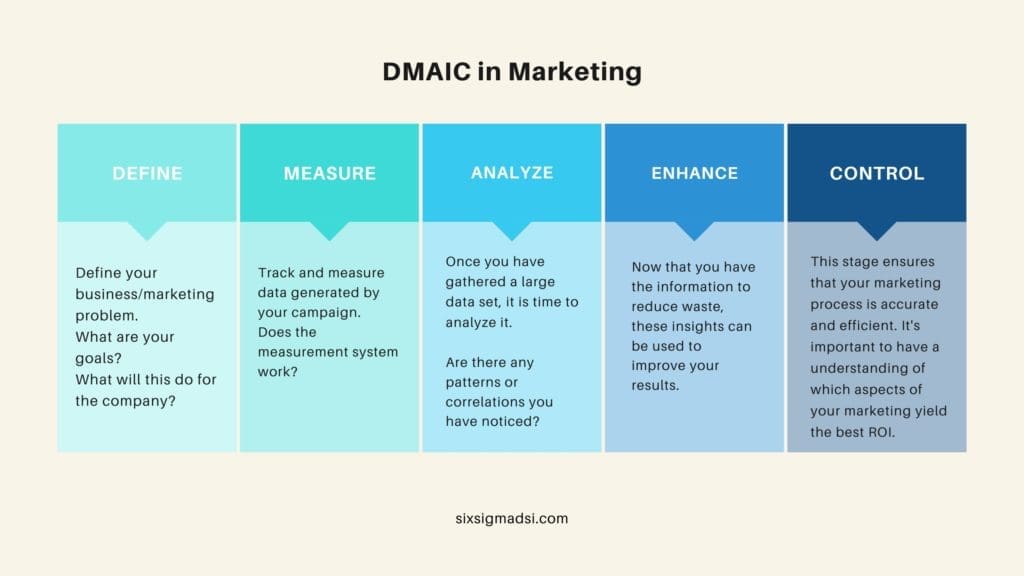Table of contents
Lean Six Sigma & Marketing: Everything You Should Know
Lean Six Sigma in Marketing challenges both the Six Sigma community as well as the marketing area to think differently about business. It provides a structured and detailed approach that is completely data-driven and allows Six Sigma to unleash its power on the critical need for revenue growth.
Lean Six Sigma Marketing (SSM), a disciplined, fact-based approach to increasing market share by providing targeted markets and products with superior value, is an example of data-driven Six Sigma Marketing. These are its key elementsCustomer value is the key strategic metric. It replaces Six Sigma’s emphasis on customer satisfaction, which both marketing and Six Sigma have embraced. This provides a stronger link to market share gains and revenue growth.SSM offers a unique collection of tools that are centered around customer value. This allows the company to focus its efforts on both new customer acquisitions and retention. It employs a modified DMAIC model (define, measure and analyze, improve, manage, control). This is familiar to Six Sigma professionals, but it’s also easy to understand for marketers. It aims to make marketing more efficient and effective within an organization. Its purpose is to reduce defects. A defect is a failure to deliver satisfactory customer experiences. Customers can interact with an organization in many different ways, including sales, billing inquiries, and service. Every interaction has the potential to increase or decrease customer loyalty, and thus the company’s market share SSM extends the traditional marketing view to include an emphasis on product pricing, promotion, distribution, and distribution.
SSM combines elements of Six Sigma and marketing to create a discipline that is focused and powerful. It is designed to increase enterprise market share and top-line revenues. This structured approach addresses the need to have more efficient and effective marketing activities in order to achieve value proposition goals at a lower cost. This is what Six Sigma has called the next generation. It’s not a focus on reducing defects or costs, but rather on increasing revenue and market share.

Marketing: How DMAIC applies specifically to Marketing
1. Define – Define your business/marketing problem. What are your goals? What will this do for the company? It is important to understand the voice of your customer (VOC) and how it will benefit the organization. Is your expected ROI? Are your goals S.M.A.R.T?
2. Measure – Track and measure data generated by your campaign. Social Media, PPC Advertising, and Google Analytics all provide extensive data. If your marketing efforts are focused offline, you can ask your customers about their referrals and measure your conversion rates. Does the measurement system work? Is there anything that could compromise the integrity of the data?
3. Analyze – Once you have gathered a large data set, it is time to analyze it. Are there any patterns or correlations you have noticed? If you are measuring social media campaigns, is it possible to see which posts have higher engagement numbers than others? Do you think it is due to key topics or visuals? Check which keywords have the highest click-through rates (CTR) if you’ve made investments in online advertising like Google Adwords. Ask yourself why something isn’t working. Ask yourself why four more times to find the root cause. Remove the sources that don’t produce the desired outputs. You should understand the relationships between your data and any trends.
4. Enhance – Now that you have the information to reduce waste, your team knows what works. Use Plan, Do, Check, and Act to confirm it. You can reduce or eliminate the amount of time and money you spend on marketing. These insights can be used to improve your results.
5. Control – This stage ensures that your marketing process is accurate and efficient. It is important to have an in-depth understanding of which aspects of your marketing spend yield the best ROI. You can control the process by creating guidelines. This could be as simple as creating an SOP for your marketing team, updating your strategy, or setting up different team guidelines to manage the process.
Marketing is a dynamic field. Marketing can be affected by economic and social factors that are almost impossible to control. In your marketing strategy, you should adopt a constant improvement mindset. You’ll be falling behind and it will cost you more to catch up.

Voices from the customer, business, process, and employees
Many voices influence how a process is built and delivered to customers. These voices are called Lean Six Sigma.
The Voice Of the Customer (or the VOC) is the first. It defines the customer’s needs and expectations. It is an important voice to be heard in order for customer value to be realized.
The Voice for the business or VOB is the second. It’s a voice that makes sure the company’s objectives are being reflected in its business processes.
The Voice of the Process or the VOP is the third. It addresses the process’s capability. It puts limitations on the process. It may be impossible to produce high-quality content on a blog if marketing staff members have little knowledge about keyword research and copywriting. This is because the VOP is not capable of providing such a service.
The Voice of the Employee (or VOE) is also essential. Their voice is crucial in the design and implementation of processes once they are designed.
Fishbone Diagram: Identifying the Problem
It is crucial to identify the root cause of a problem when it occurs. A Fishbone Diagram is a very useful tool. The head of the fish is the root cause.
If you can trace all the possible problems back to the root cause of them, it is more likely that they will be addressed.
Important Quality Characteristics
Critical to Quality (CTQ), refers to those aspects of a product/service that are critical in delivering quality outcomes.
Low Quality at a High Cost
Lean Six Sigma promises consistent and efficient output while maintaining a high level of quality. It is important to avoid poor quality. Six Sigma uses the term “Cost of Poor Quality” (COPQ) to describe a useful concept. It is the cost of delivering products or services that would be eliminated if everything was perfect. Customers return items that have not performed as expected or failed to work together, and this is called Poor Quality. Patients are discharged from the hospital and sent to the hospital for poor quality. When a series of product recalls has led to a brand being damaged, Poor Quality can be incurred.
Pareto Analysis
A Pareto Chart can be used when there are multiple performance problems with a process. This chart shows the number of problems encountered by focusing on the most prevalent problem. The six Sigma project team can pinpoint where they need to focus their attention. In fact, you might have heard of the 80/20 Pareto Rule, which states that 20% of problems can be solved if 80% of them are addressed. This means that significant improvements can be made even if all problems are solved.
Kaizen
Kaizen, a Japanese term that means continuous improvement, is the Japanese word for Kaizen. Continuous improvement is about small improvements to existing processes. These are the small changes that have been made across the organization, from the factory floor to the web sales tracking. However, the emphasis here is on the small. While there are large and disruptive changes when processes are redesigned they are not the main focus of philosophy for continuous improvement. These large changes can be addressed through separate projects.
Have you applied Lean Six Sigma strategies to your marketing efforts?
Tell us about your experience in the comments below.



















